Polar
equations define a relationship between an angle theta and a distance
r. If we think about graphing a polar equation on the x-y plane, then
the angle theta is measured from the positive x-axis and r is the distance
from the point (0,0) on the x-y plane.
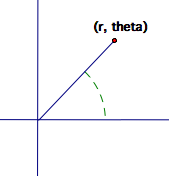
The
equation of a circle centered at the origin in polar coordinate is very
simple: r = a where a is the radius of the circle.
For
example, below is the graph of r = 3.

The
equation of line through the origin is also very simple: Theta = b where
b is an angle in radians.
For
example, below is the graph of theta = pi/4.

Polar
equations can also be used to graph some relationships with are not easily
defined in rectangular coordinates.
Let's
begin by looking at the equation  when
a = b. In this situation we get an n-leaf rose where k indicates the number
of leaves. when
a = b. In this situation we get an n-leaf rose where k indicates the number
of leaves.
a = 1, b = 1, k
= 1
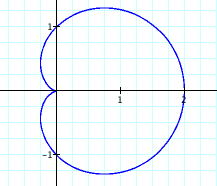
a = 1, b = 1, k
= 2
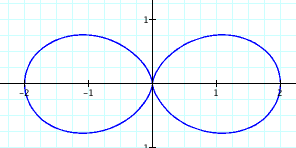
a = 1, b = 1, k
= 3
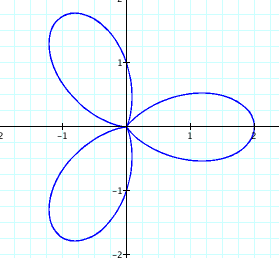
When a = b, the
sum of a and b gives us the "length" of our petals. If a = 0,
we also get an n-leaf rose and the length of the petals is 1. In the above
examples, the length of the petals is two. Below, we create a rose with
petals of length 6.
a = 3, b = 3, k
= 5
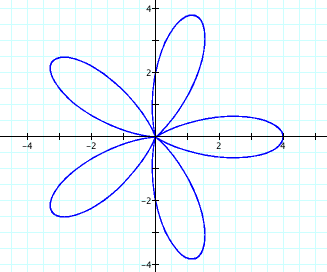
We
can change the equation from cos to sin and we will get a similar graph,
but rotated. Why does this change rotate the graph? (Discuss
that cosine and sine equal 0 and 1 for different values of theta and why
this results in a rotation.)
We can also alter
the shape of the graph by choosing values of and b that are not equal.
When a is
greater than b, the petals are not tight (meaning they do not come back
to (0,0) )but there are still k of them. The closer the value of a is
to the value of b, the "tighter" the petals.
a = 2, b = 1, k
= 3
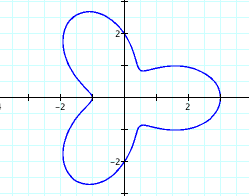
a = 5, b = 1, k
= 3
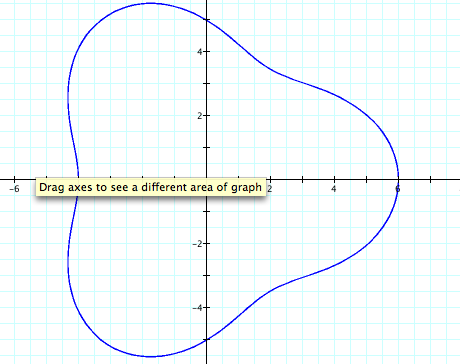
Why are
the petals not tight when a is greater than b? This question
is equivalent to asking why r never equals 0 when a is greater than b.
When a and be where equal, r = 0 when cos (theta) = -1. For example, a
+ b (-1) = a - b which = 0 when a and b are equal. When a is greater than
b, a - b is always positive and in particular never equal to 0.
When a is less than b,
the petals are tight and there are k large petals and k small petals.
The larger the difference between a and b, the closer in size the small
petals and the large petals become.
a = 1, b = 2, k
= 3
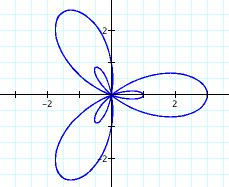
a = 1, b = 5, k
= 3
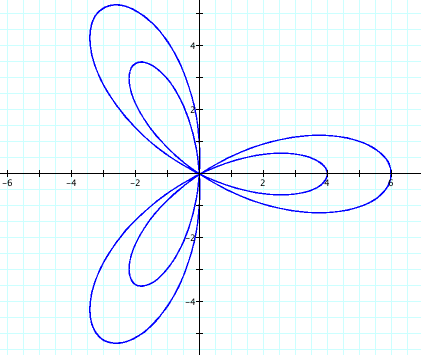
Why do
we get twice as many petals when a <b? This question is equivalent
to asking why r = 0 six times instead of three when a <b. If we look
at 0 = a + b cos (theta) if we will get that b cos (theta) = a twice for
each time cos (theta ) = -1. Once on each "side" of cos (theta)
= -1. For example, if we look specifically at 0 = 1 + 2 cos(3 theta),
we want to know when cos (3 theta) = -1/2. This will be when 3 theta =
120 degrees and when 3 theta = 240 degrees, as theta goes from 0 to 2pi
each of these happens 3 times (because the 3 coefficient on the theta
essentially takes us from 0 to 2 pi three times).
|




![]() when
a = b. In this situation we get an n-leaf rose where k indicates the number
of leaves.
when
a = b. In this situation we get an n-leaf rose where k indicates the number
of leaves.







